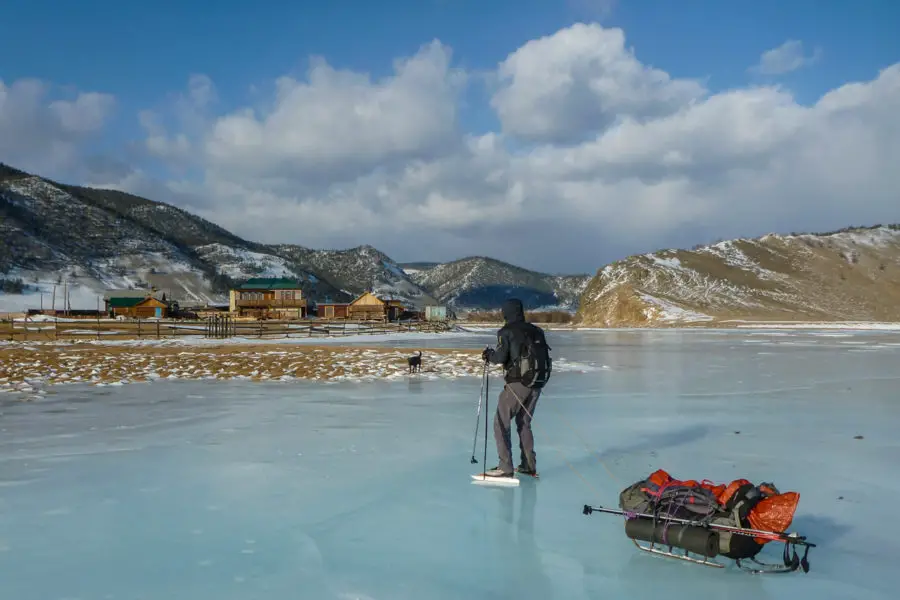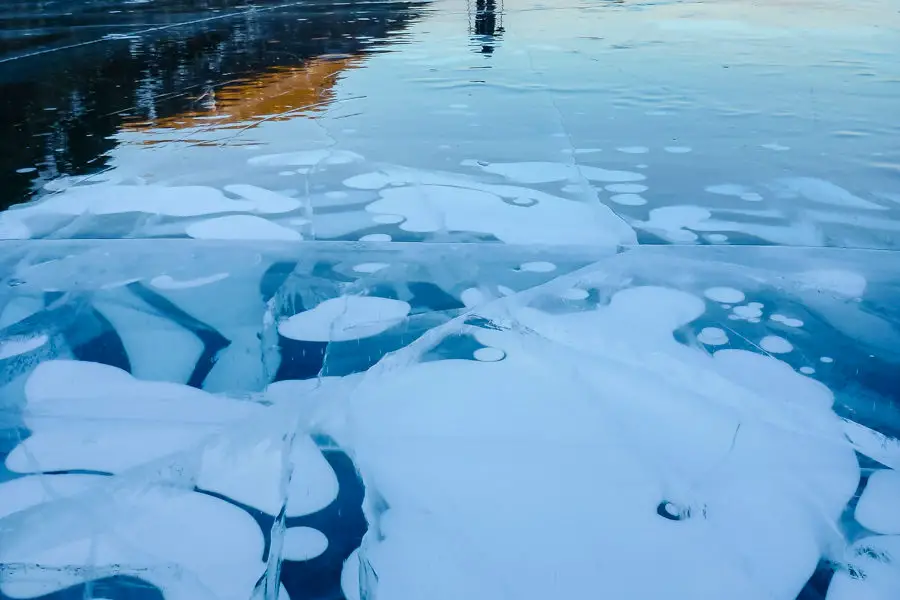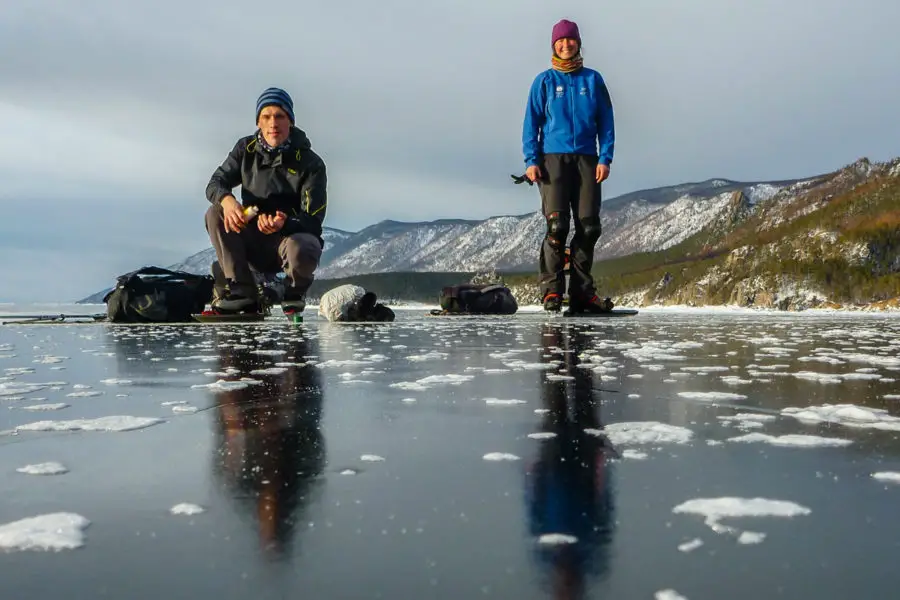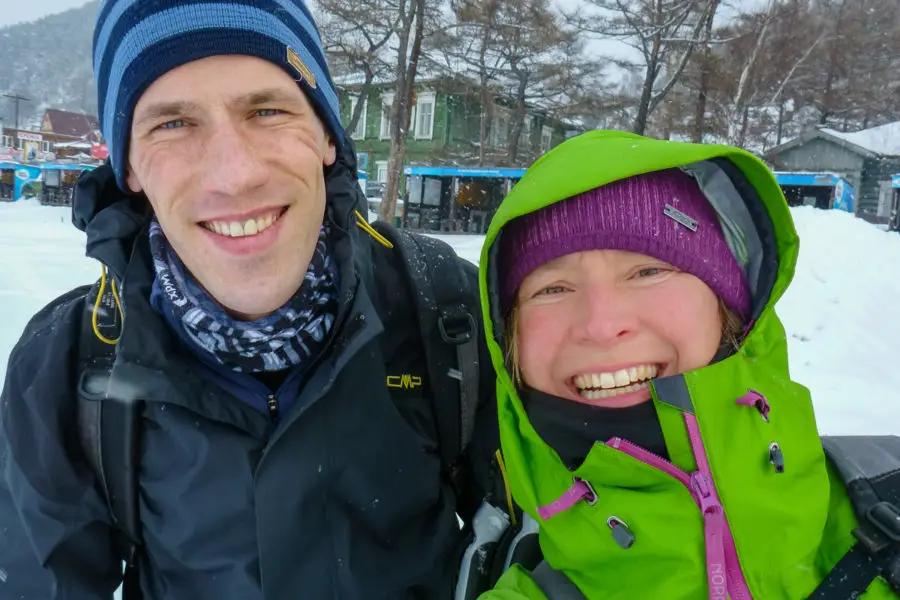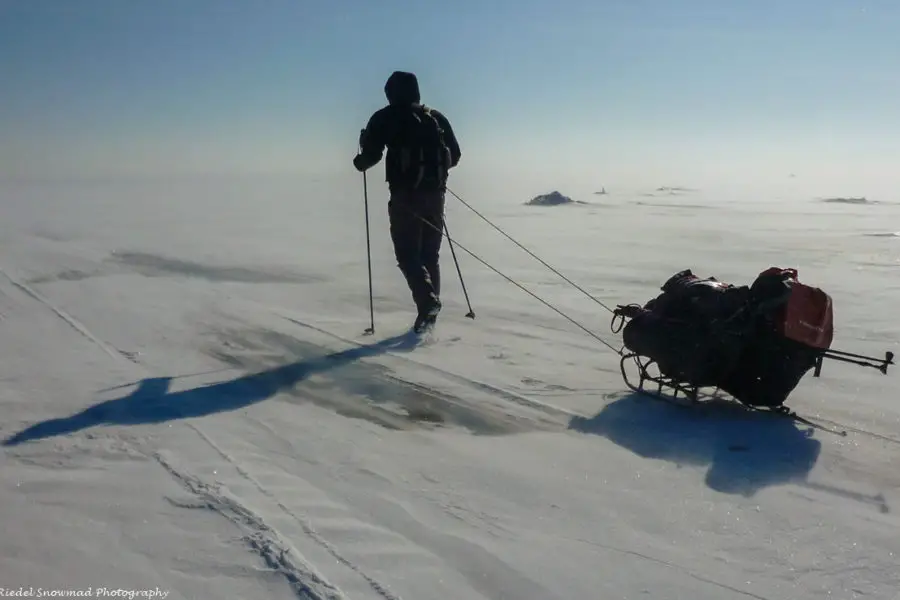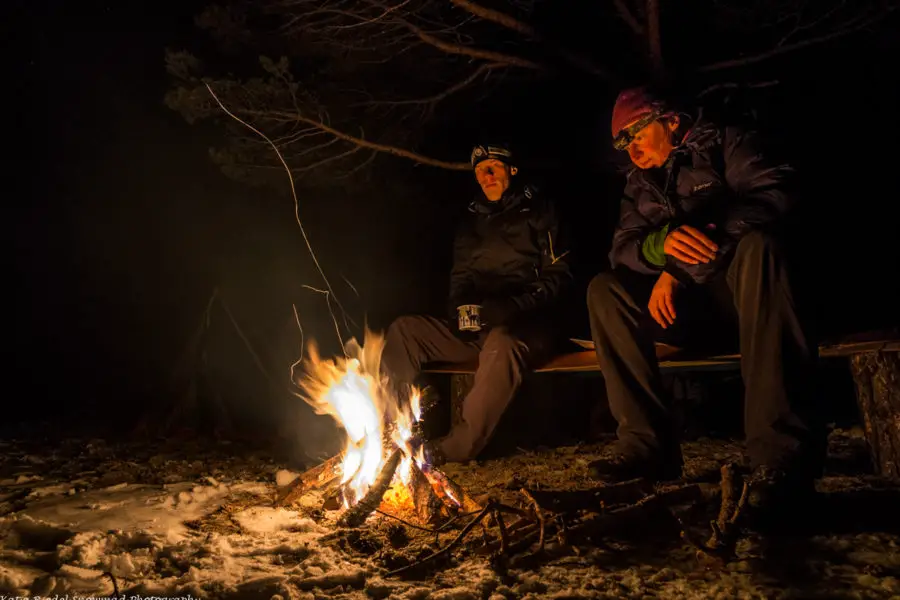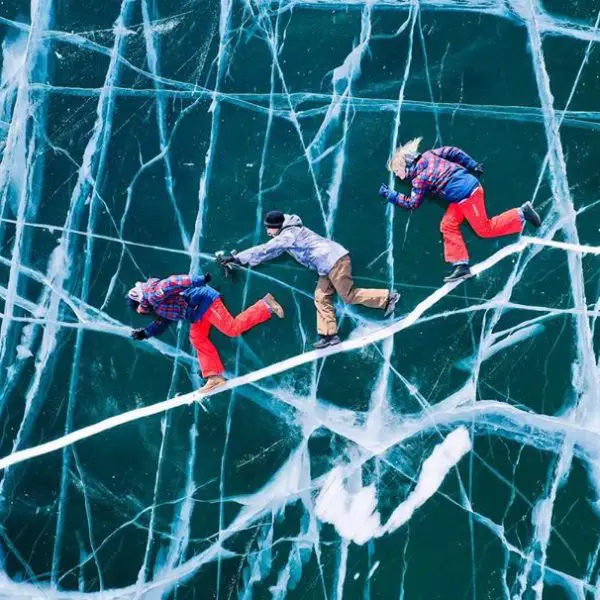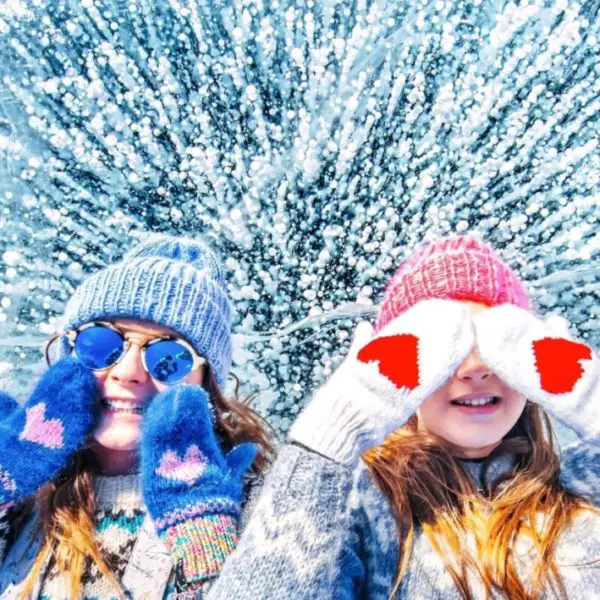My Ice Skating Across Lake Baikal Adventure - by Katja Riedel
My skates are gliding over the ice of Lake Baikal. The ice is clear and deep and crisscrossed by a spider web of cracks. Every time I put my skates down I hear new cracks forming. It is like a whisper. I know that these are only hairline cracks, but sometimes there are loud bangs in the distance, like rifle shots or thunder.
Signs that the ice on the lake is working, it is alive and expands and contracts with temperature changes. Ice skating across. The sound is unnerving, but I think I am safe. Skating across Lake Baikal fills me with a sense of calming isolation. For three days now I have been on the lake covering between 20 and 40 km each day.
My Baikal Skating Journey:
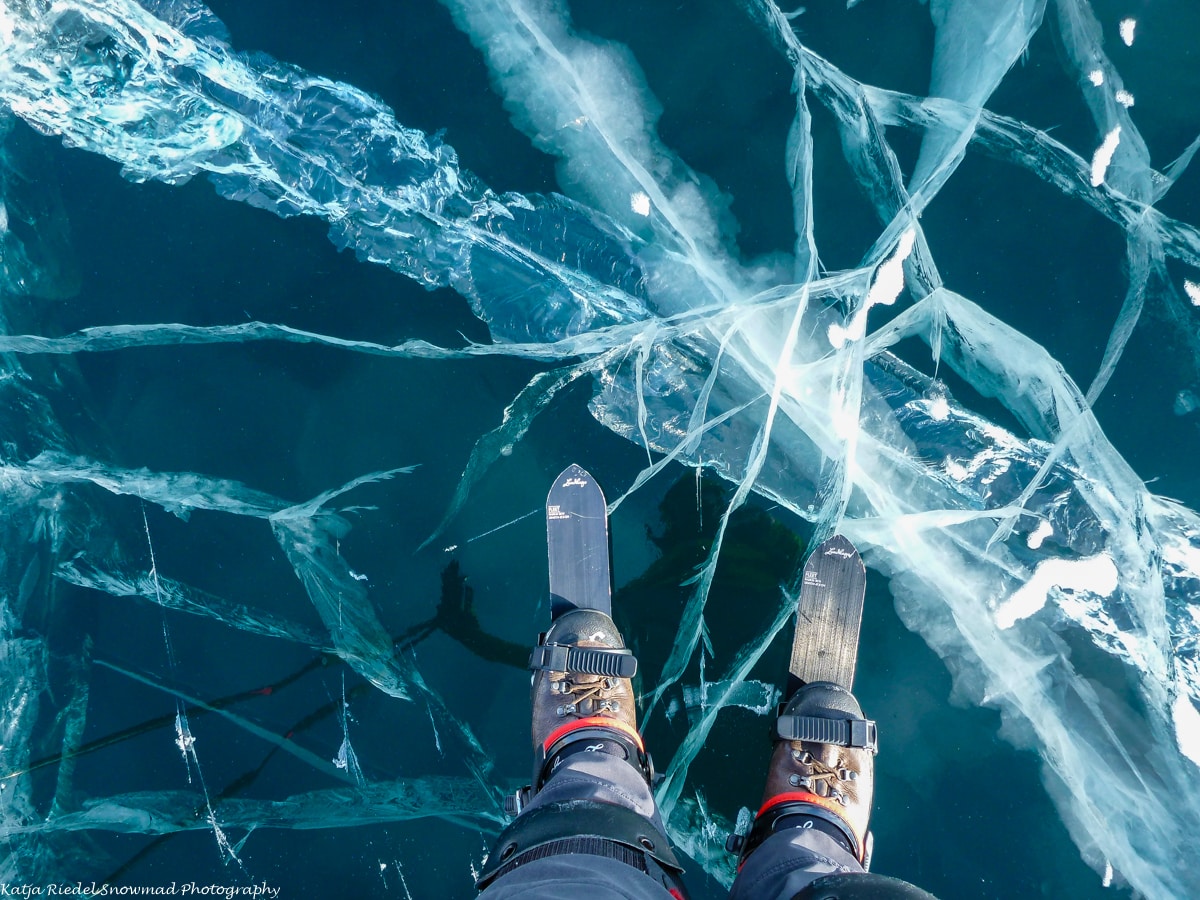
I began my journey skating across Lake Baikal, at Listvyanka, a little village to the south, where the Angara River diverts from the rest of the lake. The colourful wooden houses were blanketed in snow that had also settled on the lake and forced us to walk for the first two days. A roaring headwind on day two proved too much for skating but cleared the snow off the ice. On day three we finally put skates on. These were long distance ice skates, sourced from Scandinavia with 50 cm long straight blades that strapped to my tramping boots. My poles were equipped with sharp heavy, metal tips, good for testing the ice strength.
I was accompanied by Maksim, a 28-year-old PhD student from Irkutsk, a very good ice skater, familiar with the lake and a nice sense of humour. He spoke Russian and best of all, was also interested in photography, which meant we happily spent hours photographing ice sculptures, cliffs and cracks and bubbles along the way. All our gear, tent, sleeping, bags, food and fuel were tied to little kiddy sledges with metal runners and wooden slats that we attached to the hip belts of our daypacks. Skating across Lake Baikal with these sledges was not easy. They don’t drag on the flat ice, but seem to have a life of their own: they swing, they snag on pieces of ice, they stop when they hit a snowy patch and they take you out from behind if you stop too suddenly. Still, I liked the freedom they offered.
Our route took us along the southeastern edge of the lake. The ice was between 60 and 90 cm thick and clear. Close to shore boulders were visible under the ice and Maksim even saw a fish swimming. On day three we still battled a headwind but the ice surface was mostly clear of snow. Goggles and a balaclava protected me from the icy wind. During lunch, we huddled in the shelter of some pressure ridges. In the afternoon we passed an impressive cliff that looked like a church. It is called Bolshoy Kolokolny, Big Belltower. From his summer visits here Maksim knew a little bay called Babushka, Grandmother beach where we planned to camp. The sun was about to set as we arrived. We took the skates off, left all our gear on the ice and climbed as fast as possible through the snowy forest to the top of the cliffs. I was gulping in big draughts of cold air as I took in the panorama of Lake Baikal. Close in it was a jumble of ice thrown onto the shore, stacked high, floes looking like glassy shark fins. Further out from the cape the ice surface was flat, dark and veined by large cracks. Soon the sky took on pastel colours which were reflected by the ice. A light wind rustled the frozen tree branches. As the colours slowly faded we walked back down to the shore. Using the last light we set up camp under the trees. Pine needles promised a soft bed and some insulation from the cold ground. We lit a fire and while I looked after it Maksim cooked dinner. Later we sat a long time at the fire, drinking tea, talking and staring into the flames. The heat of the fire warmed my face, in the air the aromatic smoke of pines. Walking a few steps away from the fire revealed a sky full of stars. I thought about how long I had dreamed of visiting this place. Now I was here and as the thought sank in it filled me with happiness.
Next morning I crawled out of my sleeping bag to see the sunrise. Close to our camp water had trickled over rocks and encased them in big sheets of ice. As the early morning sun hit the ice it started to glisten. The whole shore of of the lake, looked like it had been decorated by an ice artist. There were hanging icicles, frozen waves from autumn storms, solidified waterfalls. Every rock or human structure was thickly encrusted with ice, so that it was sometimes difficult to tell what was hidden beneath. Close to the villages ships were parked up for winter, frozen in solidly, with icicles hanging from the roofs of the wheel houses. Cars and trucks drove on ice roads on the lake that were marked by vertical tree branches. Ice fishing was a favourite past time and sometimes we met locals that set nets under the ice to catch a delicacy, omul, a fish from the salmon family endemic to Lake Baikal. It is also home to has another endemic animal, the nerpa, the only freshwater seal in the world. Around 500.000 years ago their ancestors might have swum up the rivers and then got cut off from the Arctic Ocean. Unfortunately, the only nerpas I saw were two very unhappy specimens in the museum at Listvyanka.
The surface of the ice was either smooth and flat like a mirror or uneven, with ice floes that had formed in autumn still intact, but welded together by younger ice after a storm broke it up. In one area large methane bubbles rose from the lake’s depth and gave me an appreciation of the thickness of the ice. The bubbles were opaque and looked like pearls strung up on a neckless.
On our fourth day, we headed for Bolshoy Buguldeyka, a small village 3 km up the Buguldeyka River. It one of the hardest days, while skating across Lake Baikal, with headwinds so strong, that I had to take my skates off because the wind blew me backwards. Gusts from the side set the sledges off on a spin so that we had to ram our skates into the ice and wait till the gust died. Once I watched Maksim sliding on his bottom for 10 meters, driven by the merciless wind before he could stop himself. When my sledge took me out I found myself engulfed by drifting snow without orientation where was up or down, a surreal feeling. At the end of the day I was very tired and worried that I wouldn’t make the final 15 km to the farmhouse were we planned to stay for the night, but suddenly the wind was coming from behind and we flew along. When we reached the river mouth of the Buguldelka River the ice changed instantly. The river froze while the water was still moving, it was opaque and baby blue. Big ice hammocks had formed, trees were now surrounded by ice as the river broke its banks when it froze and flooded the shore. We skated without our sledges just for the joy of it till the sun disappeared behind the mountains.
The farmhouse that we reached looked neglected, but it was warm inside and we were welcomed by an old woman and her daughter. Both were busy in the kitchen as they prepared dinner, rice and smoked omul, copious amounts of tea with sugar and Russian pancakes with jam for dessert. After dinner they left and we had the house to ourselves. I was always glad when Maksim did the talking in Russian while I unloaded our sledges. We either camped, stayed at farmhouses or tourist accommodation. Normally we were the only guests, but one night we met a group of 12 Russians which had been driving on the ice from the North to the South of Lake Baikal. A long journey, since Lake Baikal is the biggest (by volume) and deepest lake in the world, 636 km long and 1637 m deep. They were a cheerful bunch. Some of them spoke English and while we shared dinner I learn more about life in Siberia.
Another night we had a small wooden house all to ourselves, no water, no electricity, but warm, thanks to a fire somebody had lit for us hours before our arrival. For lunch we normally looked for a sheltered spot at the shore, but sometimes we had to crouch behind some large pieces of ice or built a shelter with our snow foam mattresses. We sometimes met other skaters, always Russians. Some were only out for the day, some dragged sledges behind them like us. Maksim always asked about the ice conditions ahead, as this made all the difference to our progress. Normally several times during the day we had to drag, push our lift our sledges over pressure ridges. Once a crack with open water forced us to make a long detour before we could cross it safely. And always the wind. When we entered Maloe More strait at the end of a long day, the little sea between Olkhon Island and the western shore of Lake Baikal, a furious wind pummelled us. Progress reduced to a crawl. The final blow was that we had to drag the sledges uphill over a dirt road before we reached our accommodation.
The Last Day:
The last day of the trip started by carrying all our gear 100 steps down to the lake, where we battled really bad ice. It only got worse when the wind picked up and the ice turned into something resembling broken crockery. My sledge kept toppling over, I fell, I cursed, I swore. Maksim disappeared in the distance and I was furious. I finally caught up with him in the lee of a small island. We climbed the island to see how much more rough ice we had to cover. Maksim dealt out chocolate, which we ate in the sun, overlooking the lake and suddenly my frustration and anger dissipated, it was such a treat to be here. Our experience of skating across Lake Baikal from then on improved dramatically, we even had a tailwind. Soon we reached Ogoy Island with a Buddhist Stupa at its highest point. The southern tip of the island was dominated by rugged cliffs that are surrounded by beautifully cracked ice. We took photos and not for the first time I appreciated my knee protectors. They were supposed to save my knees during falls but were most useful when kneeling down on the ice for photography. We shared our last lunch sitting in the sun on the island. Coloured ribbons that were tied to the branches of the bushes as sacrificial offerings flapped in the wind.
What then followed was the best skating of the whole trip. The ice was smooth and the wind in our back. It felt effortless and exhilarating to be gliding over the ice. This was how I imagined it when I dreamt all those years about skating across Lake Baikal. Instead, during our trip, we battled headwinds most of the way. But that wasn’t important anymore, we reached Khuzhir on Olkhon Island, the final destination of our trip, roughly 250 km from Listvyanka our starting point.
We spent two more days on the island skating light-footed and unencumbered by our sledges and exploring the interior of the island on foot. Olkhon Island is an important place for shamanism which is still alive in this part of Siberia. A prominent rock, Shaman Rock, is a symbol of Lake Baikal and subject of many myths and rituals. Local people still believe in the miraculous powers of Shaman Rock and small sacrificial offerings of money, sweets and cigarettes can be found on the cliffs opposite the rock. This powerful atmosphere enhanced the experience of skating across Lake Baikal As I sat on those cliffs and watched the sun disappear behind Shaman Rock memories of the trip flooded through my mind. Not the moments when the ice was rough and everything seemed to conspire against us but the moments when I was flying. And as I lay down my own offerings I made the promise to come back.
Related posts
If you have any urgent questions or enquiries, please give us a call +61 412 587 785
